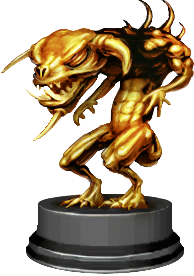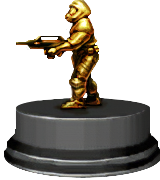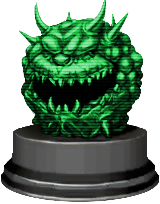-
Mordeth Award - Surprise! Released project with the longest "development time"

Doom 32X Resurrection - Victor Luchits et al
Not all of Doom's myriad console ports were made equal. And while the 32X version wasn't the bottom of the heap, it certainly wasn't near the summit. Rushed through development in a brutal crunch that required John Carmack to camp out at Sega's headquarters in Redwood City in a bid to hit the launch date for a hardware add-on that was destined to fail. Senior producer Scot Bayless would sum up the doomed effort years later: "[Carmack] worked his ass off and he still had to cut a third of the levels to get it done in time. What amazes me now is that with all that going on, nobody at Sega was willing to say "Wait a minute, what are we doing? Why don't we just stop?" Sega should have killed the 32X in the spring of 1994, but we didn't. We stormed the hill, and when we got to the top we realized it was the wrong damn hill."
And so, the 32X version sat for many years as an expensive, slightly bumpy novelty. Until January, when Victor Luchits and his team emerged out of nowhere with Doom 32X Resurrection, a staggering titan of code sitting somewhere between a ROM Hack and a source port. In effect, the entire game engine surrounding 32X Doom has been more or less replaced with a re-do based on the Jaguar Doom source code (or more specifically, Quasar's PC port Calico). The end result of this re-port, free of the confines of having to hit a a tight, arbitrary deadline, is a staggering boost in quality and performance. Whereas the original 32X release lacked some lighting detail and didn't run so much as it walked, Resurrection screams along a resolution and framerate that, while not quite at the level of the DOS original, is close enough for government work. It's honestly stunning to consider that they're both running on the same hardware!
If that was where it ended, it'd be worthy of praise enough, but no. Resurrection goes yet even further, with a completely redone (and considerably less farty) soundtrack, support for CD audio and the Jaguar Doom IWAD, more customizable controls (including Sega Mouse support), stereo sound panning, and the true cream of the crop: Two player split-screen multiplayer. On a 32X. At a playable framerate. On a 32X, the system that struggled enough with one player.
The 32X was a short-lived stop-gap killed off in favor of the Saturn, marred further by having one of the lower-quality official Doom ports. Resurrection restores some much-needed posthumous dignity to the system, and stands true testament to the incredible and slightly-terrifying homebrew coding scene surrounding Sega's hardware diaspora. Long may they continue!
Now then, if Vic and his friends are reading, about that Saturn version...
- Kinsie
-
Odyssey of Noises - Best original soundtrack for a Doom project
This year we've decided to present this as a dual award, focusing on one selection representing the midi/mus format of classical Doom music, and one representing the nascent and freewheeling digital realm.
 Arrival OST - @AD_79
Arrival OST - @AD_79
Representing traditional midi music, this year's selection is the OST for Pavera's Arrival, composed by AD_79. As an album, AD_79's work here is an all but perfect fit for the mapset it's paired with, conveying an intoxicating air of melancholy shot through with distant but all-impacting overtures to desperate hope, playing off beautifully against the lushly shadowed and topographically inhospitable worlds of Arrival, which are a joy to experience by dint of their spacious, multi-layered quality inviting constant fluid movement. In line with the modern (i.e. post-BTSX / stewboy / Esselfortium) school of midi composition, AD_79's approach is to explore a variety of moods using a relatively focused cast of voices, versus the instrumentally eclectic experimentalism of the classical era of Klem, Shaw, et al. In nearly all of these pieces, the rhythm section predominates, emphasizing forward movement and drive. Drums beats and fills are carefully measured to subliminally suggest that one ought to move-move-MOVE but also take time to drink in the surroundings; bass guitar is often functionally the lead melodic instrument, with a variety of chimes and occasional woodwind taking a prime role in providing poignant texture and countertexture, as well as serving as primary purveyors of motif/leitmotif over the course of the game. The overall impression is overcast, stormily symphonic, yet understated in the way that only truly gifted composers are comfortable being. The emotive power of this soundtrack has already been recognized by the community at large, with a number of these tracks appearing nearly as impactfully outside of Arrival itself, most notably "Digital Nomad" (m01) and "Inhabitants" (m05).
 Ashes: Afterglow OST - @PRIMEVAL
Ashes: Afterglow OST - @PRIMEVAL
Representing the hi-fi realm, this year's selection is the impressively robust soundtrack for Vostyok and ReformedJoe's Ashes: Afterglow, courtesy of the multitalented Primeval, who you may remember from last year's Bastion of Chaos, among others. As a TC, Afterglow is a paean not only to 1980s post-apocalyptic road movies but to 1980s grindhouse/genre cinema in general, and Primeval is able to effortlessly keep pace with this eclectic tapestry of musical references and influences. Afterglow is a significantly more slow-burning and atmospheric affair than its predecessors, and its variety of decayed and rad-poisoned vignettes afford Primeval space to explore more eerie and minor-key moods reminiscent of Fabio Frizzi or even Goblin in tracks such as "Undercity" or "The Gap", while overworld and more expressly action-oriented sequences ala "Lazer Tag" revolve around pulsing, driving electronic beats falling somewhere between Jesper Kyd and (Scuba would not forgive me if I failed to make the reference) the mid-period scores of John Carpenter. Added to this is Primeval's own modern context and personal voice, with many of the more ambient soundscapes moving away from straightforward 80s melodicism in favor of trudging trip-hoppy beats juxtaposed with jangling guitar strums, fuzzy noisescapes and just a touch of the author's signature crusty rhythm and dramatic electric lead guitar. As a whole, the Afterglow OST is as diverse as the ruined biosphere the game's protagonist traverses, and proof positive that a musical work can successfully be both a faithful, studied genre piece and a fresh new observation at the same time.
-
Codeaward - Most noteworthy programming effort of the year
In a typical year, the Codeaward would be a project-focused dedication. It even started out that way in 2021, with our boy kraflab furiously advancing the development of the speedrunner-oriented PrBoom+ fork he's in charge of - dsda-doom, named after the eponymous archive. What seemed like a niche choice for dedicated tryhard dorks suddenly grew wings and became a major force on the source port market.
Let's start with the sweet nerd stuff: Rewind frames, oh baby. This means the port stores save states continuously and lets you... rewind the game with a keypress and jump back to stored keyframes. Is it cheating? Yes. Is it the heavens smiling upon you after you died to a stupid trap 20 minutes past your last save? It's okay, my child, you are loved.
Next: on the fly map restarts. This may sound trivial, but it was a seismic change in the speedrun community. In the past, grinding a short speedrun meant hundreds of application restarts just seconds apart. And let's say Windows is not up to that task repeated for several hours. Well, nowadays grinding demos has never been so much fun! (Please ignore that it has never ever been fun.)
Now we need to talk about heresy. Betraying God has never been more faithful in 20 years! kraflab decided that he will implement full support for Heretic and Hexen, and in the process dsda-doom became the most precise emulation of the original games, outperforming even the chocolate variants in vanilla demo playback. This may have provided a spark to the illustrious-but-tiny Heretic/Hexen speedrun community, may they live long and prosper.
Yet it was the end of the year when the other shoe truly dropped. kraflab introduced basic (and experimental) implementation of the Hexen-in-Doom format, opening the gateway to supporting ZDoom maps. Now let's calm down, everyone, this is NOT a hostile Ztakeover. Yet. This is rudimentary support for early Zdoom maps which doesn't even include slopes, ZDoom's ACS, Decorate or any of the billion Zdoom features accrued over the years. Yet.
At this point we finally get to discuss why the dedication surpasses dsda-doom and extends to kraflab personally. Have you heard about our Lord and Saviour MBF21? Let me spin a tale. Once upon a time, there was a port called Marine's Best Friend, an odd extension of Boom. And then it sort of went nowhere, because ZDoom became the hegemon, except when PrBoom+ implemented support for it as the infamous "complevel 11". Everyone accepted cl11, but no one ever used it (until Valiant, the big famous MBF-based project). And then fabian's source port Woof came along and proved that cl11 was a big stinky sham. Not only did it show that pr+'s implementation was unfaithful, it also reminded us of "options", a lump that lets mappers specify how the map should behave without the hardcoded defaults pr+ mandated.
And thus, complevel 11 was dead, long live complevel 21. kraflab assembled a task force of elite nerds that would help revive true MBF, but also abuse this situation to push for subtle fixes and changes. And so they did. The result is one of the most impactful moments in the past decade(s), because it provides extension to Boom mapping with a clearly defined standard that's implemented in dsda-doom and Woof, and it's getting there in GZDoom, Eternity, Retro, Odamex and perhaps more. Trust me, if you haven't heard about it yet, it will come to a theatre near you.
Oh and then there's DSDhacked, a specification that removes limitations of Dehacked namespace sizes to enable "unlimited everything" (other source port developers hate him). It's meant to be a future-proof solution, but it is attempting to supplant already existing solutions, so we'll see how this battle pans out several years down the line.
All in all, kraflab has achieved a lot this year, and he's drawn himself an audacious plan to follow up, so keep an eye on him, perhaps we'll see him here yet again.
- @dew
-
Machaward - Most creative, unusual, or artistically compelling project of the year

Ever since Doom 64 was remastered last year, it’s seen an unprecedented resurgence in relevance. Some projects have opted to bring the unique sprites and sounds into Doom II projects, some just use the weapons, but custom content specifically using Doom 64’s engine has been quite sparse- well, until now.
Scwiba’s “The Unmaking” contains 40 levels akin to a box of chocolates- each unique and more flavorful than the last. While it’s essentially a mixed bag of concept maps, it exudes an interesting cohesion, both in its quality and overall atmosphere, doing a good job at revisiting many of the eerie corridors, rusty space platforms and ornate demonic fortresses that made Doom 64 so memorable in the first place. The scale, however, is definitely on another level, for never have those towers in the mist been so tall and unnerving, never have those dark strongholds under a fiery green sky been so majestic and terrifying. The UnMaking is also a follow-up to scwiba’s other Un* projects, known for their creative gimmicks and mapping tricks, except now, with the scripting system, spooky ambience and expanded featureset that only Doom 64 can provide, and it is worthwhile to look at a few examples to illustrate the creativity on display here.
In “Ghost Stories”, the techbase’s seemingly abandoned corridors occasionally see ghosts pop up, only to disappear shortly afterwards, fading away into the darkness, all thanks to the built-in spawning system of D64. Are they monsters waiting for the right time to strike, apparitions from the past being shown again as a warning, or merely figments of your own imagination? In “Blast Processing”, the ammo-starved player releases a series of homing fireballs which he then has to “herd” into a series of immobile cacodemons, should he want to proceed: not only is it a creative use of the rarely used D64 projectile and the scripting system of the engine, but also a fun spoof on the (in)famous revenant projectile herding tactics that some slaughtermaps employ. In “Do Not Wake Mother”, Doom 64’s favorite new enemy takes the center stage as the player is required to find a series of switches to shut down the doors leading to the Motherdemon, for that is the only safe way to render her unable to hear the gunshot you will need to activate the switch leading you out of the building.
For as many maps follow in the Doom 64 footsteps thematically, the UnMaking nevertheless remains unafraid to create some strange and unique scenarios. Prismatagoria is easily the strongest example of this, its use of solid textures giving the map a strange sense of emptiness in the rooms of tall white towers but then bursting forth with vibrant colors and geometry straight out of a synthwave music video. In Remember the Hellamo, the well-loved invasion style gets an extra kick with waves of enemies silently conjured up in the distance, their shadows mysteriously convening through the red sea, onto the broken fortress you’re to protect with your last breath. Good Night and Good Luck, the penultimate map, employs constricting darkness to either make you move quickly, or to squeeze you into the smallest space it can, leaving you holding on for dear life while fighting the enemies you can only hope make themselves known by their eager attacks.
The UnMaking, then, is not only a fitting conclusion to scwiba’s puzzle series, and a great, inventive megawad all its own, but, with due hope, may it act as the harbinger for a renaissance of Doom 64 custom content going forward. Bring it on!- @Dynamo / @Major Arlene
-
 Creator of the Year - @Tarnsman
Creator of the Year - @Tarnsman
Some Creators of the Year storm the scene and claim the crown with a grand entreé that leaves no one second guessing. Others grow into it over several years, showing a steady learning curve towards greatness. Some return from a lengthy hiatus with a bombastic comeback, dazzling us with mature competence of a project that knows what it wants to be. And then there's a very small group of Doom journeymen who seem to hang around since forever, showcasing their skill and brilliance with every contribution they make. Except those drip in slowly, spread between various community projects, speedrunning sessions and secret unreleased megawads. Members of this last group often garner everyone's respect for a long time, but pinning them down to a certain year tends to be futile.
Unless... they decide to have a statement year. We saw this happen with Lainos and dobu gabu maru in the past, however I'd say even their hallmark years pale in contrast with the show Tarnsman has put on in 2021.
Tarnsman's been considered the prodigal child ever since he entered the scene in roughly 2011. Yet he immediately ensnared himself in a string of high and low-profile team projects that included Doom 2 the Way id Did, Back to Saturn X, The Adventures of Square, Abyssal Speedmapping Sessions and a whole bunch of other names that ensured he was signed under everything and... well, nothing. Year after year after year, Tarnsman had credit to a map or seven here or there, but not really a star project tied uniquely to his name. But this whole time the mad mapper was scheming and planning. Deep down in his underground base atop of a secluded mountain, he was dilligently designing for a better half of the last decade.
And then, inside of two months, Tarnsman released a 32-map vanilla-compatible pseudo-parody on Doom the Way id Did, and a four episode, 36-map partial conversion megawad for the Eternity Engine. Simply outrageous. I will leave it up to my colleagues to sing the proper odes to those particular projects, but let us focus on the man of the hour. Throughout his career Tarnsman proved to be a grandmaster of synthesis, and his ability to riff on other mappers becomes absurdly clear in this year's crop. Where D2TWID provided careful analysis of Doom 2's design tropes, D2ISO mixes the original and the derivate and infuses both with irreverent parody, not allowing rules to stand in the way of a good chaingunner eff-you trap.
Furthermore there's Tarnsman's Projectile Hell, a project almost completely dedicated to mess with the player and murder them dead with unfair ambushes and gotcha scenarios. In this ode to Valiant (among other things), Tarnsman embodies skillsaw's dark side and asks "what if it was all bastard-tough Touhou-like bullet hell meta with glass cannon balance and anime references?" Like recreating the exquisite technique that went into painting Mona Lisa, except moving her in space. And replacing the smile with ahegao face. And if you think the many ways you die playing these maps are cheap and unnecessary, Tarnsman might ask you to record yourself crying about it. It's his house and his rules.
We also shouldn't forget that Tarnsman organized a mapping contest this year that celebrated his 10 year anniversary in the community, one that yielded some award-worthy content and gave the winners a big fat reason to smile. Read: the winner got a thousand bucks from him, so you could say people were motivated to join and try their best. But that too should be covered by a separate article. All in all, Tarnsman prepared quite a spectacle for us to close out his Decade of Doom and it's only fair we give back a little something to him.
- @dew






